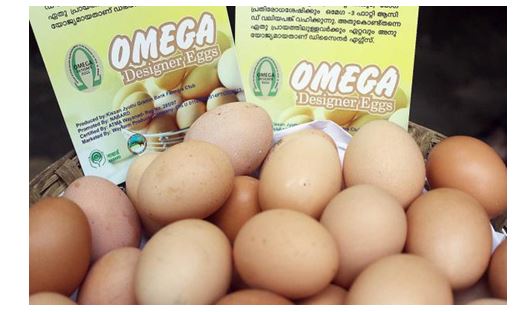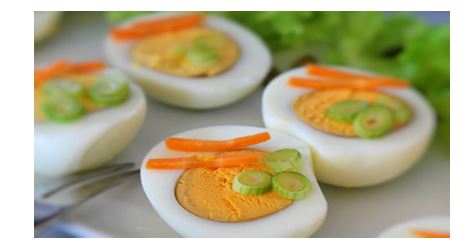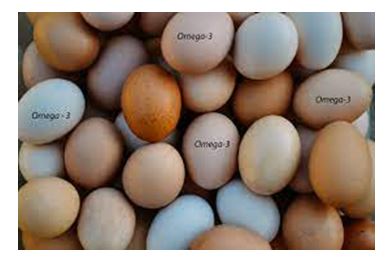Introduction
In the last decades people became highly aware of the connection between food and health that has led to the convergence of their attention on the nutritional quality of foods. The food industry has responded to the demand for foods of superior health benefits by modifying the nutritional profile of foods like eggs. Consumer awareness on the relationship between dietary lipid and the incidence of Coronary Heart Disease (CHD) changed their attitude towards food consumption. Consumers are always in search of newer products with potential health benefits.
Among various foods, egg is an important and easily available food delivering balanced essential nutrients to the body and egg is the best medium for incorporating health components in it. The designer food approach has been explored widely using egg in providing various essential nutrients to the human body, which are not usually present in required quantity. These are also called as Enriched eggs or Nutritional Enhanced Eggs Designer Eggs, Pre-Ovipositor Value Added Eggs, Health Promoting Designer Eggs or Enriched ω-3 Eggs.
Definition
Designer eggs are those in which the content has been modified from the standard egg in terms of high vitamin and minerals, lower cholesterol, high omega fatty acids & pharmaceutical compounds. Designer egg approach was started in 1934 by Cruickshank. He reported the modification of fatty acid composition in egg yolk by making feed interventions. Omega-3 fatty acids are proved to be beneficial in various disorders such as cardiovascular disease, hypertension, autoimmune, allergic, and neurological disorders. Sim and Sunwoo developed designer egg rich in omega-3 fatty acids and antioxidants by feeding hen with flax seed in which saturated fatty acid in yolk was replaced with 3-poly unsaturated fatty acid (PUFA) i.e. the yolk triglyceride is replaced by linolenic acid and yolk phospholipids are replaced by longer chain omega-3 fatty acids, such as eicosapentaenoic (EPA), dososapentaenoic and docosahexaenoic (DHA) acids. Fortification of omega-3 fatty acid not only increases the health benefits of designer egg but also reduces the cholesterol content of the egg by replacing saturated fatty acid in egg yolk.
Designer eggs were also developed by replacing yolk cholesterol with conjugated linoleic acid (CLA). CLA is studied for its various health related properties such as anti-adipogenic, anti-carcinogenic, anti-atherogenic and anti-inflammatory. Produced designer egg enriched with CLA by feeding hens with CLA rich diet and found that adding CLA to layers diets rich in omega-3 fatty acids produces CLA enriched eggs. CLA supplementation of egg also increased yolk moisture content, firmness and impaired the sensory quality of eggs.
Cholesterol content of the egg yolk can also be reduced by supplementing hen’s feed with chromium at 200–800 ppb concentration (13.9 to 33.7 % reduction. The pharmacological approach was also studied for reducing cholesterol level in egg by administering egg laying hens with cholesterol lowering drugs. US patent was issued for the method of reducing the cholesterol content of egg by supplementing hen with L-dihydroxyphenylalanine (L-DOPA). Selenium (Se), a micronutrient is essential for preventing cardiac muscle degeneration. Fortify the egg with increasing amount of Se, reduce the risk and prevalence of prostate and colon cancer and it also proved to have a role in prevention of cardiovascular diseases through antioxidant.

Varieties of Designer Eggs:
- Shell colour – Regional consumer preferences determine the shell color F. Kuhl estimated that half of the designer eggs on the market are brown shelled.
- Yolk colour- Yolk color can vary from virtually white to orange depending on the deposition of xanthophylls from the feed. Sources of supplemental xanthophylls include corn gluten meal, alfalfa, marigold, peppers and spirulina.
- High vitamin content – particularly vitamin A and E. Although, the vitamin content of eggs varies with the diet of hen but the hen may also differ in transferring the different vitamins with different efficacy. It is highest for vitamin A (60-80%), vitamin B12, riboflavin, biotin and pantothenic acid (40-50%), vitamin D3 and vitamin E (15-25%). So the attention should be there for the economic production of high vitamin eggs.
- High mineral content – Increasing the micro mineral contents of yolk & albumin especially selenium, iodine, zinc, copper and chromium by dietary supplementation. Iodine deficiency exists in India, so eggs could be a good source for its supplementation. Selenium level in eggs can be increased by incorporating the selenium yeast in diet of hens.
- Alteration in the pigment content –The yolk colour is the indicator of pigment content of egg and varied with dietary supplementation such as plants viz., marigold, chilli or corn, blue green algae spirulina. Recently in a study, it was found that high intake of carotenoids reduced the macular degeneration, a major cause of blindness in the elderly.
- Low cholesterol- An average sized egg contains approximately 200-220 mg of cholesterol. Supplementation of chromium to laying hen diets at concentrations of less than 1 ppm have shown to lower egg cholesterol and also improve the interior of the egg. The low cholesterol eggs can be obtained by feeding a all-vegetarian diet rich in protein and fiber fortified with vitamin E.
- Fats & fatty acids profile – The omega-3 essential PUFA include linolenic acid and its derivatives EPA (Eicosapentanoeic acid) and DHA. High content of this fatty acid also increases the keeping quality and shelf life of the eggs. Studies have also been conducted on the egg having the lower saturated and unsaturated fatty acid ratio by feeding the hen with canola oil.
- Pharmaceutical operations – through biotechnology genetically modified chickens are produced which then produce the eggs containing the desired compound e.g., insulin for the treatment of diabetic patients.
Specific antigen injects into hen body

Antibody formation starts and flow in blood, then concentrate in egg.

Collection of antibody from the egg and use it in human health care.
Biological compounds – chicken can also produce antibodies that can neutralize the antigens of bacteria, viruses etc. These antibodies circulate in the blood and transferred to eggs for the protection of chicks.
In India, NABARD-supported Kisan Jyoti Farmers Club (KJFC), WAYFARM like groups are producing designer egg containing Omega-3 Fatty Acids.

Conclusion
Designer eggs provide options for consumers who want eggs with different nutritional benefits or properties than generic eggs. A generic shell egg provides a nutrient dense, high quality, inexpensive source of protein as well as a variety of essential vitamins and minerals, with other functional components. By feeding hens special diets, eggs can offer functions above and beyond the excellent nutrition that they already provide.


Department of Animal Nutrition, College of Veterinary and Animal Sciences GBPUAT, Pantnagar, U.S Nagar,Uttarakhand- 263145. *Corresponding Author Mail id – bhattshriya03@gmail.com















